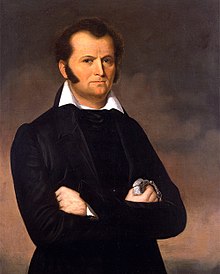
Back James Bowie Afrikaans جيمس باوي Arabic James Bowie Catalan James Bowie Czech Боуи Джеймс CV James Bowie Danish James Bowie German James Bowie Spanish جیمز بویی Persian Jim Bowie Finnish
James Bowie | |
|---|---|
 Bowie c. 1831–1834 | |
| Nickname(s) | Jim Bowie Santiago Bowie |
| Born | April 10, 1796 Logan County, Kentucky |
| Died | March 6, 1836 (aged 39) Alamo Mission, San Antonio, Texas |
| Allegiance | Republic of Texas |
| Years of service | 1835–1836 |
| Rank | Colonel |
| Unit | Texian Militia |
| Commands | The Alamo San Antonio |
| Battles / wars | |
| Signature | |
Colonel James Bowie (/ˈbuːi/ BOO-ee[1][2][3])[a] (April 10, 1796 – March 6, 1836) was an American military officer, landowner and slave trader who played a prominent role in the Texas Revolution. He was among the Americans who died at the Battle of the Alamo. Stories of him as a fighter and frontiersman, both real and fictitious, have made him a legendary figure in Texas history and a folk hero of American culture.
Bowie was born on April 10, 1796, in Logan County, Kentucky. He spent most of his life in Louisiana, where he was raised and where he later worked as a land speculator. His rise to fame began in 1827 on reports of the Sandbar Fight near present-day Vidalia, Louisiana. What began as a duel between two other men deteriorated into a mêlée in which Bowie, having been shot and stabbed, killed the sheriff of Rapides Parish with a large knife. This, and other stories of Bowie's prowess with a knife, led to the widespread popularity of the Bowie knife.
Bowie enlarged his reputation during the Texas Revolution. After moving to Texas in 1830, Bowie became a Mexican citizen and married Ursula Veramendi, the daughter of Juan Martín de Veramendi, the Mexican vice-governor of the province. Bowie led an expedition to find the lost San Saba mine, during which his small party repelled an attack by a large Native American raiding party. This enhanced his reputation, although they didn't find the mine.
At the outbreak of the Texas Revolution, Bowie joined the Texas militia, leading forces at the Battle of Concepción and the Grass Fight. In January 1836, he arrived at the Alamo, where he commanded the volunteer forces until an illness left him bedridden. Bowie died on March 6, 1836, with the other Alamo defenders. Despite conflicting accounts of his death, the "most popular, and probably the most accurate" accounts maintain that he died in his bed while defending himself against Mexican soldiers.[4]
- ^ Evans, John (December 1989). "Bowie (Boo-wee) or Bowie (Bo-wee)? What's in a Name?". Alamo Journal. 69: 6.
- ^ Davis, William C. (1998). Three Roads to the Alamo: The Lives and Fortunes of David Crockett, James Bowie, and William Barret Travis. New York: HarperCollins. p. 35. ISBN 0-06-017334-3.
- ^ Manns, William (May–June 2004), "The Bowie Knife", American Cowboy, 11 (1): 40–43;
- ^ Cite error: The named reference
Chariton74was invoked but never defined (see the help page).
Cite error: There are <ref group=lower-alpha> tags or {{efn}} templates on this page, but the references will not show without a {{reflist|group=lower-alpha}} template or {{notelist}} template (see the help page).